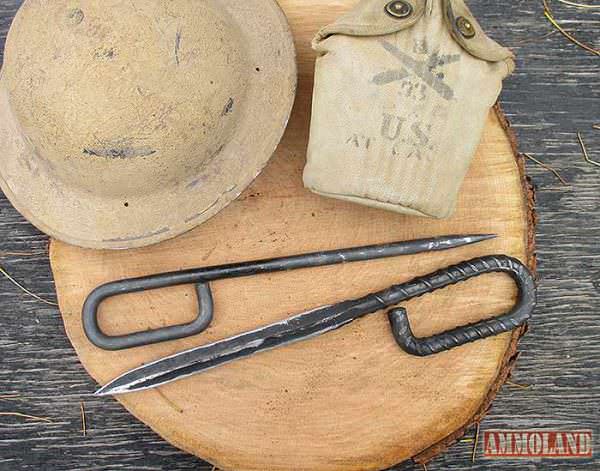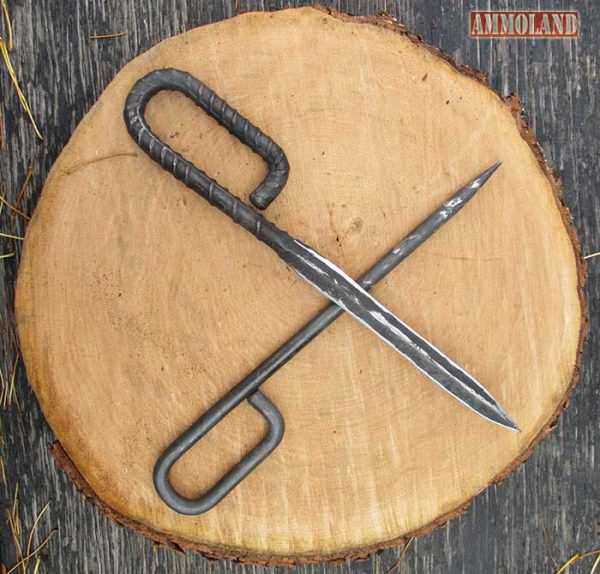By Major Van Harl


Wisconsin –-(Ammoland.com)- The lines had been drawn and both sides had dug in for the years long slug fest of destruction and death.
Trench warfare had come to eastern France and before WWI was over an entire generation of young European men had been decimated.
Artillery, high explosives and the machinegun seemed to rule the battlefield. The front line soldier of any of the armies on either side of that conflict was a rifleman first. This meant he was armed with a bolt action rifle and a bayonet to stick on the end of that rifle.
Trenches were dug into the earth to get the men below ground level, to protect the troops from the next artillery barrage. The problem was the leadership left the men in the trenches around the clock and those dirt-works became home, a miserable home at best.
Go get your grandfather’s old Springfield rifle and attach the bayonet to it. Then try walking down the hallway of your home and see if you can deploy this overly long weapon in such a tight space.
When you see photos of today’s soldiers with their very short assault rifles you might think that is normal. Maybe in 2016 but not in 1916.
Long, clumsy, one shot at a time, bolt action rifles were the norm. The US did not enter WWI until 1917 and by then they understood that the average soldier would need something a bit more handy and a lot more maneuverable in the close confines of the trenches.
The US went out of its way to arm all of its soldiers on the front lines of WWI with a handgun, as well as their standard issue rifle.
But handguns were what only officers and some senior NCOs carried in European armies. So if you were a soldier in those armies in 1915 and you were fighting hand-to-hand out in the narrow spaces of trench warfare, you needed something short, handy and possessing a edge and/or point.
What you needed was a trench knife, and pulling your bayonet off the end of your rifle in the middle of a night time sneak attack was not going to work.
You needed a knife you could pull out on a moment’s notice and thrust it into that enemy soldier who was coming over-the-top of your trench to try and kill you with his sharpened entrenching tool shovel. The problem was the French government drafted everyone they could get their hands on to include the cutlery and knife makers of France. There was a shortage of trained men who could manufacture the never ending demand for knives to use on the front lines.
The truth of the matter was the average soldier on either side did not need a well built, factory made knife, he just needed something to fight with in close quarters that got the job done. So he made his own stabbing device.
Metal bars that were used to hold up barbed wire in no-man’s land, an area that was between both apposing armies, was scrounged to make French Nails. The crude but very effective knives were made by the blacksmiths working their trade on both sides of the frontlines of that war. The metal bars were heated and a rounded handle and blade was formed. Some French Nails had a simple to manufacture point on the end, sort of like when you put a pencil in a pencil sharpener.
Remember how sharp that pencil was until you start writing with it? Remember your grade school teacher telling you not to poke someone with your sharpened pencil. Your pencil could have been used as a wooden French Nail. Luckily you always followed the safely rules in grade school, right?
If your WWI blacksmith had more time he could beat that metal bar flat on one end and make you an actual knife blade on your French Nail. A blade that you could sharpen to allow you to slice up your French baguettes and slather on your American peanut butter as you tried to eat in your trench.
Now if the enemy came over-the-top during dinner, you wiped off the blade and went back to war.
Milwaukee Nail & Waukesha Spike

I wanted a French Nail and the very few WWI era ones command high prices. I really wanted a newly made one that I would not feel guilty about using, so I found a blacksmith in Milwaukee, WI. I went to him with my project and he developed a couple of prototypes for me to see, and for him to practice making French Nails. We discussed French Nails with just a sharp point and French Nails with an actual blade.
When I went back to see the prototypes I told the blacksmith I was going to write a column about the knife and my plan was to name the Wisconsin version of the French Nail, the Milwaukee Nail. One of the men in the blacksmith’s shop suggested the knife with just the point should be the Waukesha Spike. So the Milwaukee Nail and the Waukesha Spike were born.
On my third trip I stood next to the anvil as the blacksmith heated the steel and pounded out the two knifes. The Waukesha Spike does not take near the man hours to make as the Milwaukee Nail did with its double edged blade. When they were done they were both impressive and yes deadly.

The Milwaukee Nail is not a paper weight or something that will wind up on a shelve with other military memorabilia. It is a weapon and I presume to carry it in the future, as such. With the hot metal rolled around to form the handle it also creates a hand guard that can double as a blunt force weapon. You do not always have to cut evil to stop evil.
Check Your State Laws
Some states allow a conceal weapons carry permit holder to conceal on their person a fixed blade knife and in some cases, brass knuckles or a weapon that combines both in a handy package. The Milwaukee Nail is that handy package.
Wolfgang Schweizer, the German Blacksmith of Milwaukee, Wisconsin (https://www.germanblacksmith.com/) is in the business of making Milwaukee Nails and Waukesha Spikes. They are not decorations, or toys or as I said paper weights.
Milwaukee Nails are weapons, strong, well constructed, and meant for the business of delaying evil. Prices are based on whether you want a Milwaukee Nail or a Waukesha Spike and the type of steel you want used. A Waukesha Spike is $35 or $55- if it is stainless steel. The Milwaukee Nail is $120 and $150 – if you want it handmade in stainless steel.
There are cheap reproduction French Nails on the market made from mild steel. These are the paper weight ones, not Mr. Schweizer’s Milwaukee Nails.
Mr. Schweizer is a master blacksmith with over thirty years experience and it was actually quite fascinating watching him swinging his hammer making the first Milwaukee Nails.

No two Milwaukee Nails are alike. They are not mass produced–they are made by hand, one at a time.
Hard times are coming and in my old age I never want to have to face evil with only a knife, but if that were to happen, then my Milwaukee Nail is what I want in my hand that day.
In the world of stopping “walkers” at close contact, a Milwaukee Nail would be a front line weapon in a modern day conflict and struggle for survival–stop the brain to stop the pain.
There are three ways to handle evil with a Milwaukee Nail, you cut it deep, you cut it wide and you cut it often.
Major Van Harl USAF Ret. / [email protected]
About Major Van Harl USAF Ret.:Major Van E. Harl USAF Ret., a career Police Officer in the U.S. Air Force was born in Burlington, Iowa, USA, in 1955. He was the Deputy Chief of police at two Air Force Bases and the Commander of Law Enforcement Operations at another. He is a graduate of the U.S. Army Infantry School. A retired Colorado Ranger and currently is an Auxiliary Police Officer with the Cudahy PD in Milwaukee County, WI. His efforts now are directed at church campus safely and security training. He believes “evil hates organization.” [email protected]

Your comment of ” There are three ways to handle evil with a Milwaukee Nail, you cut it deep, you cut it wide and you cut it often.” made me laugh. It reminded me of a man I used to know who said that key to winning a knife fight is “cut ’em deep, cut em wide, and cut em ‘sho nuff’. And, ‘cut em firstest’.
Very cool article, something that I’m going to have to try and make. Thank you Major.
Very interesting article. For ONCE, an article which did not have political overtones. Whew. What a needed relief.
Great article!
And what a great innovation of old that you researched and repeated. Well done my friend!
Can not conceal in North Carolina, but you can open carry a knife that long.
Guess what else you can not conceal in NC. a sling shot.
American ingenuity at its finest. If I were a real promoter of cottage industries (I am) I would suggest that if you are anywhere near this man’s business you pay him a visit and pay him cash for one of these, for obvious reasons for those of us who cherish truly free enterprise.
I believe these could be used to get you out of trouble if you fell though the ice while hunting Polar Bear.
Any idea what grade or alloy of steel the Milwaukee smith used? One of the photos appears to show one made of standard rebar, generally a low grade and soft steel. Easy to work, but not tough. Maybe he hardened or heat treated it? The other appears to be made of some other round-bar stock. Any idea what? I’d hate to spend all the time/energy needed to make one but have a “noodle” that would not hold up or be able to keep an edge. Great article….. and I loved the bit about WHY our current military use the short… Read more »
I would suggest 1050 or 1060 carbon steel. Straight carbon steels are the easiest to work and heat treat. Check out anvilfire.com, the site has lots of info.
As stated he is using stainless steel, most likely 304 or 316 or possibly 409 but finding stainless rebar is hard, stainless rod is salty.
This is a very interesting story and it reminds me of my grandfather who was a blacksmith in Fairfield, Texas during the early 1900’s. My uncle, the baby of the family, died during the attack of Pearl Harbor on the Battleship, USS California. It was weeks before my grandfather and grandmother got the news of his death and they were devastated for the rest of their lives. My grandmother had no outlet for her grief, but grandfather’s was to make handmade Bowie knives from discarded cross-cut saws and other high carbon steel metals that he considered to be good knife… Read more »
Very cool and educational article. Making a Milwaukee nail out of rebar would be an easy and rewarding project.
i want one man thats cool how much for one thanks
Excellent article Major! I would like to see more Historical based articles like this in Ammo Land. For all us Military Collectors and History buffs, stuff like this is solid gold. Keep it up!